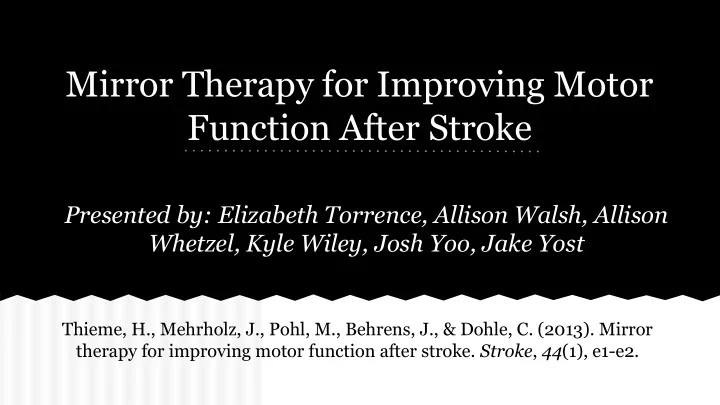

Mirror Therapy for Improving Motor Function After Stroke Presented by: Elizabeth Torrence, Allison Walsh, Allison Whetzel, Kyle Wiley, Josh Yoo, Jake Yost Thieme, H., Mehrholz, J., Pohl, M., Behrens, J., & Dohle, C. (2013). Mirror therapy for improving motor function after stroke. Stroke , 44 (1), e1-e2.
Introduction Objective: summarise effectiveness of mirror therapy for improving motor function, ADLs, pain and visuospatial neglect in patients after stroke Stroke one of the leadings causes of long-term disability (WHO 2008) ● ● right after stroke onset, 80% of survivors have upper or lower limb motor impairment ideally, intervention would focus on practicing functional tasks ● ● patients with severe paresis after stroke electromechanical training devices, electrical muscle stimulation, repetitive passive or ○ assistive movement Mirror therapy can be used to improve motor function after stroke ● ● based on visual stimulation rather than somatosensory input mirror is placed in the patient’s midsagittal plane ● ○ reflects movements of the non-paretic side as if it were the affected side PRISMA checklist: included title, abstract, methods, results, discussion, and funding
Methods Inclusion Criteria: ● Randomized Clinical Trial ● Compared mirror therapy to another therapy, no therapy, or sham therapy ● Included video and virtual reality interventions ● Participants must have paralysis of the upper limb, lower limb, or both ● All types, severities, and stages of stroke ● Outcomes measured post-intervention and at least 6 mo. later Primary Outcome: Motor Function ● Measured with Fugl-Myer Assessment, Motor Assessment Scale, Brunnstrom Stages of the UE/LE, etc. ● Facilitates collection of data
Methods Secondary Outcomes: ● ADLs (Functional Independence Measure) ● Pain (Visual Analog Scale) ● Visuospatial neglect Search included several different databases such as Cochrane Stroke Group’s Trials Register, MEDLINE/PubMed, PEDro, World Congress of Physical Therapy conference proceedings Two authors independently search databases and discussed inclusion/exclusion (with a third researcher if necessary)
Methods Analyzed 155 studies, and 14 studies met the inclusion criteria ● 567 total participants Extracted methods of randomization, blinding, loss to follow-up, details of interventions, and outcomes
Methods Assessment of risk of bias The Cochrane Handbook for Systematic Reviews of Interventions ● ● PEDro scale Assessment of reporting bias Sensitivity analysis
Results Comparison 1: Mirror therapy versus all other interventions ● Motor function ○ Post-Intervention Data (11 studies included) ■ SMD 0.61, 95% CI: 0.22-1.0, p=0.002 ○ Change Scores (9 studies included) ■ SMD 1.04, 95% CI: 0.57-1.51, p< 0.0001 ● ADLs (4 studies included) ○ SMD 0.33, 95% CI: 0.5-0.60, p=0.02 ● Pain (5 studies included) ○ SMD -1.10, 95% CI: -2.10 to -0.09, p=0.03 ● Visuospatial neglect (1 study included) ○ SMD 1.22, 95% CI: 0.24- 2.19, p=0.01
Results Mirror Therapy: ● Effects were stable at 6-month follow-up with no adverse effects reported
Results Comparison 2: Subgroup analysis - upper versus lower extremity ● Motor function: Upper extremity:P = 0.03 Lower extremity: P = 0.05 Comparison 3: Subgroup analysis - sham versus other intervention ● Not a statistically significant difference between subgroups, P=0.22 Comparison 4: Sensitivity analysis by trial methodology ● Categories: Studies without randomized cross-over trials (P=0.005), with a total PEDro score > than 6 (P=0.004), with adequate sequence generation (P=0.007), with adequate concealed allocation (P=0.005), with adequate intention-to-treat analysis (P=0.02), and with blinded assessors (P=0.002) Comparison 5: Post-hoc sensitivity analysis - removing studies that only included studies with complex regional pain syndrome after stroke ● Motor function at end of intervention (P=0.0007) and 6 months follow-up (P=0.002), Pain at end of intervention (P=0.002)
Discussion -Mirror therapy is effective for improving motor function, ADL’s, and pain when used in adjunct to conventional therapy. -The effects were more prominent when compared to a sham therapy and less prominent when compared to bilateral arm therapy with unrestricted view (conventional treatment). -Therefore, mirror therapy should be used in conjunction with other therapies and not as a replacement for current therapies. -This indicates the need for more large-scale studies comparing mirror therapy to conventional treatments.
Bias In short, the researchers sent an email questionnaire to previous test subjects in order to identify issues with the studies. Many of the studies were relatively unbiased … the Yun study was bias and the Manton-study subjects did not provide a sufficient response to email questionnaire. Issues investigated: -Random sequence generation: 10 studies have appropriate randomization -Allocation concealment: 8 studies concealed the allocation of treatment. (Researchers were unaware to which group they were assigning participants.) -ITT analysis (intention to treat): 6 studies performed an ITT analysis … this avoids the effect of subjects switching treatment arms or dropping out (which contradicts random assignment). -Blinding: For many of the studies, the therapists and participants were not blind, however, the assessors were blind in all studies accept the Yun study. (The assessors did not know which intervention was applied when accessing improvement.)
Reference Thieme, H., Mehrholz, J., Pohl, M., Behrens, J., & Dohle, C. (2013). Mirror therapy for improving motor function after stroke. Stroke , 44 (1), e1-e2.
Recommend
More recommend